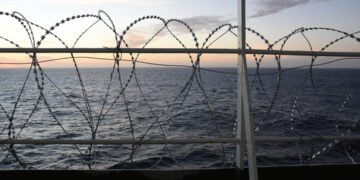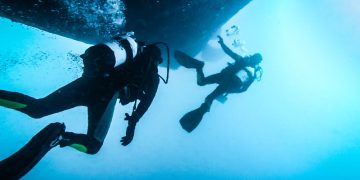NTSB has published an investigation report into an incident where the towing vessel Baylor J. Tregre capsized and sank while towing the barge MARMAC 27 during severe weather in the Gulf of America.
The incident
On May 13, 2024, about 1657 local time, the towing vessel Baylor J. Tregre was towing the ocean barge MARMAC 27 in the Gulf of America, about 23 miles south of Galveston, Texas, when the towing vessel capsized and sank (see figure 1 and figure 2).¹ All four crewmembers abandoned the vessel and were rescued by the US Coast Guard. One crewmember sustained minor injuries. There was no pollution reported. Damage to the towing vessel was estimated at $2 million.
Analysis
On May 13, 2024, while towing the barge MARMAC 27 astern on an 800-foot-long wire, about 23 miles south-southwest of Galveston, the Baylor J. Tregre encountered severe weather, listed to port, capsized, and subsequently sank. The crew abandoned the vessel into the liferaft and were rescued by Coast Guard responders.
While the tow was underway, the crew received daily weather reports from the operating company. According to the mate, the daily weather report for the day of the sinking forecasted a possible chance of thunderstorms throughout the day into the evening. This weather report matched the initial NWS local coastal waters forecast, issued at 1409—about 3 hours before the casualty—of scattered thunderstorms during the afternoon and evening hours. However, beginning an hour later, the NWS issued a series of Special Marine Warnings, forecasting severe thunderstorms and urging mariners to “move to safe harbor.” The Baylor J. Tregre mate did not recall hearing any updated weather forecasts over VHF radio and thus was unaware of the Special Marine Warnings. However, even if the Baylor J. Tregre crew had received the Special Marine Warnings, they would not have been able to avoid the storm, given the vessel’s speed (about 4-5 knots), the tow’s position (about 17 miles from Galveston and surrounded by storms), and the speed of the storm’s advance.
The weather deteriorated quickly as the vessel transited west-southwest in the Gulf of America, approaching the oncoming storm. According to the mate, the wind intensified suddenly: The captain estimated winds were about 85–100 mph (about 74–87 knots), and the closest NWS location reported winds gusting up to 48–62 knots (22–27 miles from the casualty site). Between 1647:04 and 1654:20, the vessel’s speed dropped from 4.0 knots to 0.6 knots—almost a full stop—likely from the increased winds acting on the barge and, to a much greater degree, the production platform fixed to the barge. Unable to avoid the storm, the mate attempted to steer the Baylor J. Tregre so that the tow would be downwind. However, the storm quickly overtook the tow, and the mate lost sight of the barge. The force of the wind on the MARMAC 27 pushed the barge to the south of the Baylor J. Tregre, causing the towline to exert force on the stern of the tugboat, pulling the stern and essentially halting the tugboat’s forward motion, which affected the crew’s ability to steer the tugboat. The crew stated that the towline was off the tug’s port beam “tight as a banjo string” and that the barge was dragging the tug “sideways and backwards at 3.5 knots.” The crew also stated the tug heeled to port 45°. Although the crew attempted to change the tug’s heading, the towline force and heel to port prevented them from maneuvering the tow into the wind.
The Baylor J. Tregre’s captain stated that, when he arrived in the wheelhouse, the vessel was listing to port and the main deck stern bulwarks were underwater, thus indicating the deck edge was already immersed. Additionally, the crew stated they had to climb out of the wheelhouse through the starboard door because the port wheelhouse door was almost in the water. Deck edge immersion is often associated with the maximum righting arm for a vessel, meaning the vessel is more susceptible to a loss of stability (capsizing) if subjected to further heeling forces. In their continued effort to decrease the heel to port, the captain and mate attempted to change the tugboat’s heading to bring the towline directly off the stern instead of over the port bulwark, but they were unsuccessful, and the vessel continued to heel and capsize.
After the vessel lost stability and was laid over to port, it would have flooded through any openings. These openings could have included the fiddley blowers (on the second deck), which were missing when the vessel was salvaged; windows, which blew open during the storm; or, to a lesser degree, exterior doors, with their hinges and sealing gaskets found deteriorated after the casualty. These openings would have allowed water to flood the vessel’s interior spaces, causing it to eventually sink.
Releasing the tow could have reduced the risk of the vessel capsizing. However, there was no emergency release function in the Baylor J. Tregre wheelhouse, nor was one required. Instead, to release the towline, a crewmember would need to start the winch engine in the upper engine room, and another crewmember would need to operate the winch controls located in the doghouse, aft on the second deck. The mate attempted to reach the doghouse to release the tow, but the doghouse was inaccessible because it was partially submerged. Additionally, even if the mate could have reached the doghouse, the winch engine was not running, and the engine room was inaccessible because the vessel was heeling so far to port.
Conclusions
Probable Cause
The NTSB determines that the probable cause of the capsizing and sinking of the towing vessel Baylor J. Tregre was the mate’s inability to maneuver the tow into the wind due to the overwhelming towline force generated by the towed barge during the sudden onset of severe weather, resulting in unrecoverable heeling.

































































